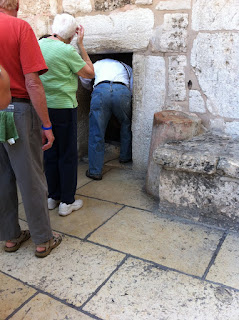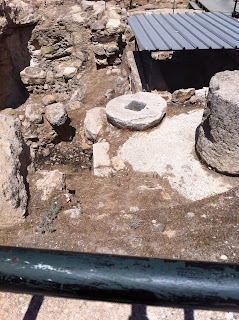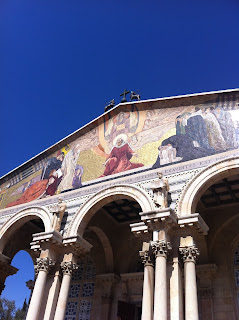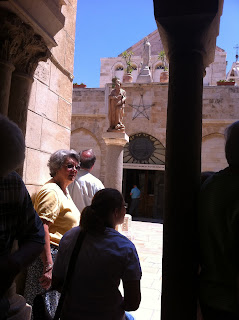When the Church of the Nativity opened we headed over there. It is on the top of a hill and the church is where "tradition says" Christ was born. This location was where Jews who followed Christ used to come and worship after he was killed. Hence, "tradition says." Now I am about to give all of you a history lesson that will blow your mind. Here goes. Back 2000 years ago, people in Bethlehem used to establish their homes in caves. If they had enough money, they would build an external structure either on top of or in front of the cave. I can't remember what the structure was called if they built it on top of the cave, but if it was built in front it was called an inn. And if the family had the extra structure the cave was then used to house the animals - the stable. So here you go and see if you can follow. Most likely, Joseph still had family in Bethlehem, probably his parents. When he returned home for the census he probably went home, but there was no room for him and Mary in the house (inn), so they were put in the cave behind the house (the stable), where Mary gave birth. Reconcile that with the images of them going from hotel to hotel and being turned away. When I heard that I had an "ah ha" moment.
Now for some more history. Everything in the area that has a church has a history that goes something like this: A church is built, the area is taken over by someone else, the church is destroyed and a new one is built. That group of people are then conquered, the church is torn down and a new one built. This goes on and on through 2000 years. But during the Ottoman empire, the emperor in Turkey had a brilliant idea. He would sell all these "Christian sights" to these different churches and make money. On a few of the most important sights, he sold the same plot of land to ALL the different churches who were interested, which has caused a lot of tension between the churches ever since. The Church of the Nativity is one of those that was sold to the Greek Orthodox, Franciscans, and Roman Catholic and each of the churches has their own section dedicated to their faith. The main area where they believe Christ was actually born and the manger they believe he was laid in is shared and each church takes their turns keeping it and holding worship services. It makes for some interesting architecture with the Greek Orthodox taking the cake for opulence.
We arrive at the church and get a little history lesson (which I just gave you), and then we are able to go in. Here is the door you go through to get in. They made it that small to keep out soldiers who would otherwise enter to desecrate the churches. You enter into a stone "entryway" before walking into the Greek Orthodox Basilica. There are very ornate lanterns hanging from the ceiling and at the front of the church are statues and paintings depicting Christ's birth. Everythig was gold plated (or straight gold, for all I know). We had to wait in line as people went downstairs to the place where Christ was born - into a cave. When we made it down there we gathered as a group into the back and one of us from the group, who had brought her bible, read the account of Christ's birth. It was a neat experience. We left there and quickly toured the Catholic church. It was much more subdued, yet beautiful. (I will post all of my pictures at the end of this post because of the disaster the last one was.)
 The teeny, tiny door you go through to get into the church
The teeny, tiny door you go through to get into the church Inside the Basilica
Inside the Basilica The place they believe Christ was born
The place they believe Christ was born
"Original" mosaic floor of the Basilica
Statue in courtyard outside Catholic church. Can't remember who it is, sorry.
After the Church of the Nativity we went to the Shepherd's Field. This is where a group of archeologists spent time studying history and geography to find a place which would likely be where the shepherds were when the angels came to announce the birth of Christ. The garden is beautiful and well maintained with trees and flowers. 2000 years ago it would have been a field covered with short grasses. There is a small chapel there, a cave, and an excavation site. Inside the chapel there are 3 paintings depicting the announcement of the birth of Christ. It was beautiful. And to make it even more special, we sang "Hark the Herold Angles Sing." The acoustics in there were perfect for singing. Then we entered the cave while our tour guide, Claudia, gave us some more history. When they looked for this field, they chose a place with a cave because that is where the shepherds would have taken their flocks to keep them away from wild animals. Something very important back then. Caves were very important 2000 years ago. The one thing that caught my attention more than anything is its location in relation to the city of Bethlehem. It is definitely on the outside of the city, and sits lower on the hill than the city. So when, in the scriptural account, the shepherds went "up" to the city of Bethlehem, they quite literally had to go up. I used to think the use of the word "up" was used merely as a relative directional reference meaning just "go." But it really meant they went "up" in elevation to get to the city. Interesting.
 Painting 1 inside the chapel
Painting 1 inside the chapel Painting 2 in the chapel
Painting 2 in the chapel
Inside the cave
 Some of the excavation
Some of the excavation
 Some of the grandmas loving on David.
Some of the grandmas loving on David.
 The view from The Church of All Nations
The view from The Church of All Nations
 The Church of All Nations
The Church of All Nations
 2000 year old olive tree in the Garden of Gethsemane
2000 year old olive tree in the Garden of Gethsemane
 More of the grove of 2000 year old olive trees
More of the grove of 2000 year old olive trees
 Ceiling inside the Church of All Nations
Ceiling inside the Church of All Nations
 Some of the excavation
Some of the excavation Some of the grandmas loving on David.
Some of the grandmas loving on David.Following that we had lunch down the street and then we went back to Jerusalem to the Church of All Nations and the Garden of Gethsemane. Most of the trees on the Mt. of Olives no longer exist. Now there are many buildings the cover the hillside. But a few of the trees that existed 2000 years ago are still there and still producing olives. They are kept behind a wall adjacent to the Church of All Nations and they are amazing to see. Gethsemane means the place they pressed the olives for the oil. They know this is the right area because ancient oil presses have been found here. They, of course, do not know WHICH tree Jesus prayed at, and inside the church is a stone, which I'm going to assume is where those who built the church think Jesus prayed. It is a beautiful church and a beautiful garden. And it is amazing to think that you are standing on holy ground where the ultimate sacrifice for our sins took place. It is a reverent place to be.
 The view from The Church of All Nations
The view from The Church of All Nations The Church of All Nations
The Church of All Nations 2000 year old olive tree in the Garden of Gethsemane
2000 year old olive tree in the Garden of Gethsemane More of the grove of 2000 year old olive trees
More of the grove of 2000 year old olive trees Ceiling inside the Church of All Nations
Ceiling inside the Church of All NationsNext came the 2nd Glenn Beck event: Courage to Remember. By the time our bus arrived most of the seats were full, so we went straight to the back. On each seat was a water bottle and a little LED light. Some were white and some were blue. I'm not sure if they were meant to spell something out, or what the purpose of the blue ones were, because the only mention of them was toward the end and we lit them up during a song. Anyway, we sat down and someone pointed and said, "There's John Voit." Sure enough, he was over near the entrance signing autographs and taking pictures with people. I have this funny thing about celebraties. I tend to leave them alone because I think they are normal people and I know I would be annoyed if everyone was always asking me for a picture. So, I stayed back, used my zoom, and tried to get his picture. By the time I was ready to hit the button, he had moved and was behind people. So its hard to see him, but he is there.
This event focused on the Holocaust. There was a panel of people on stage and they discussed different topics. One of which was how the head of the Corrie Ten Boom foundation said never before in history had Christians banded together in support of Jews. There had been a few throughout history, but overall most Christians had seen the Jews as "Christ killers" and had been the cause of much of the Jews horrific past. Now there was a growing group who vows to never again let something like the Holocaust happen. And I am proud to say I am one of them!
There was also a video shown of a woman who filmed her grandfather returning to his childhood home in Germany. He had left Germany at 15 and gone to Israel alone during the war. His parents were later rounded up and killed. He had never had a desire to go, but his granddaughter was persuasive that it was time to heal the wounds. It was a very emotional piece. Originally she shot the entire trip as simply a way to remember and to catch her grandfather's feelings as a family record. After watching it she realized she had something more and wanted others to see it. David was tired, hot and fussy, so I spent a great deal of this time standing in the back and bouncing him. as I was doing this a woman walked up to me and said she was a reporter for an online newspaper based out of Boston (she told me the name of it, but I can't remember what it is) and can she interview me. So that was fun. I don't know exactly what was said in the article, but if I was mentioned in it at all it was probably that I was a mother of 6 who came from Morocco with a 5 month old baby. That seemed to be what a lot of people focused on.
The event had some beautiful music and a great spirit. And I always have believed that you can not stop talking about the Holocaust and all that lead up to it, as well as what followed it. I am glad I was there.

























